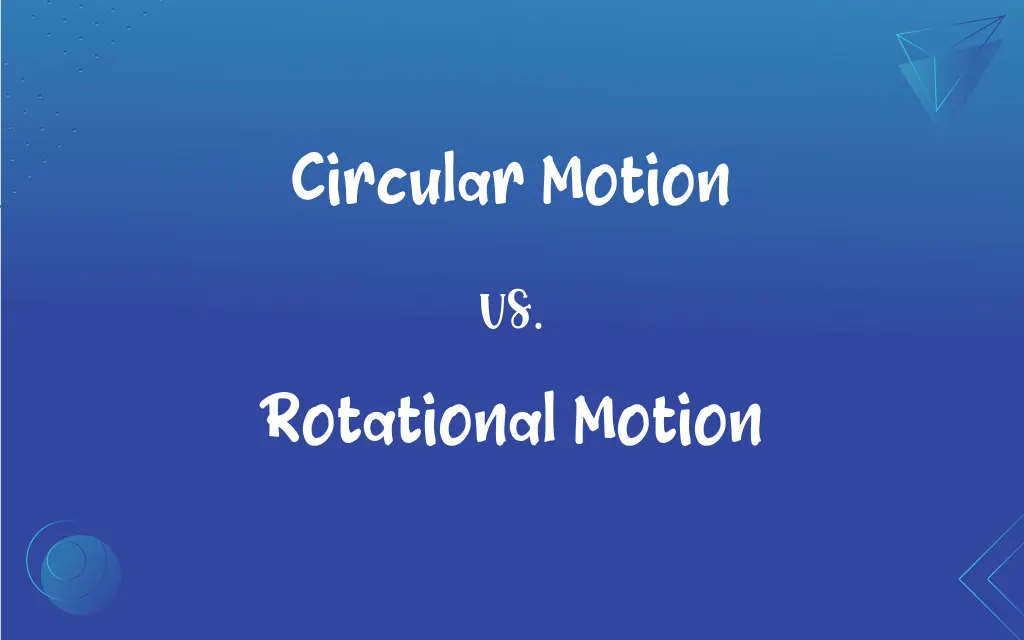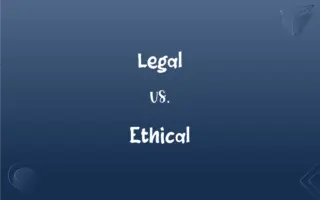Circular Motion vs. Rotational Motion: What's the Difference?
Edited by Aimie Carlson || By Harlon Moss || Published on November 27, 2023
Circular motion describes an object moving in a circle at a constant distance from a point; rotational motion involves an object rotating about an axis.

Key Differences
Circular motion pertains to the movement of an object that traverses a path equidistant from a fixed central point. It's the motion we observe when a point or an object moves in a circle, like a car on a roundabout. Rotational motion, conversely, refers to the action of an object turning around its own internal axis. This motion can be seen in objects like a spinning top or the Earth revolving around its axis.
In circular motion, the object remains at a consistent distance from the center as it moves, maintaining the circle's radius. This stands in contrast to rotational motion, where different points of the rotating object might have different velocities, due to the varied distances from the axis of rotation.
To put it in simpler terms, circular motion could be imagined as a point on the edge of a spinning disk, always moving in a circle. Rotational motion would refer to the entire disk turning around its center. The entirety of the disk, every point on it, participates in the rotational motion.
One might sometimes confuse these terms since any object in circular motion can also be said to exhibit a form of rotational motion. However, not every rotational motion can be described as circular motion. For instance, while the hands of a clock show circular motion, the entire clock mechanism demonstrates rotational motion.
Comparison Chart
Definition
Movement in a circle at a constant distance.
Object turns about its own internal axis.
ADVERTISEMENT
Path
Constant distance from the center.
Distances vary from the axis of rotation.
Velocity
Constant for a particular object.
Varies based on distance from the axis.
Example
Point on the edge of a spinning disk.
Entire spinning disk.
Relation
A subset of rotational motion.
A broader concept that includes circular motion.
Circular Motion and Rotational Motion Definitions
Circular Motion
Constant distance from a central point.
Planets exhibit circular motion around stars.
ADVERTISEMENT
Rotational Motion
Angular movement of an object.
The blades of a fan undergo rotational motion.
Circular Motion
A continuous curved path.
Satellites exhibit circular motion around planets.
Rotational Motion
Movement around an internal axis.
A spinning top displays rotational motion.
Circular Motion
Movement of an object in a circle.
The Earth's moon follows a circular motion around Earth.
Rotational Motion
Turning movement of an object.
The Earth exhibits rotational motion around its axis.
Circular Motion
Motion maintaining a constant radius.
A child swinging a toy on a string demonstrates circular motion.
Rotational Motion
Whole-body motion around a particular axis.
A merry-go-round showcases rotational motion.
Circular Motion
Uniform movement along a circle's circumference.
The hands of a clock display circular motion.
Rotational Motion
Object's points have varied velocities.
In a rotating wheel, the center moves slower than the outer edge.
FAQs
Do objects in circular motion maintain a set distance from the center?
Yes, in circular motion, the distance from the center remains constant.
What is circular motion?
Circular motion refers to an object's movement in a circle at a constant distance from a central point.
Do all points in an object undergoing rotational motion move at the same speed?
No, different points might have varied velocities based on their distance from the rotation axis.
Can one object show both motions simultaneously?
Yes, for instance, the Earth rotates on its axis (rotational) and orbits the sun (circular).
What's a common example of rotational motion?
A spinning top is a classic example of rotational motion.
What's the main difference between the two motions?
Circular motion involves a fixed path around a center, while rotational motion is about an object rotating on its axis.
How is rotational motion defined?
Rotational motion involves an object rotating about its internal axis.
Is circular motion a type of rotational motion?
Yes, circular motion is a subset of rotational motion.
What factors affect rotational motion?
Factors include torque applied, moment of inertia, and angular momentum.
Which motion involves the whole object turning about an axis?
Rotational motion involves the entire object turning around a specific axis.
How are velocity and acceleration handled in circular motion?
Velocity constantly changes direction, and there's always a centripetal acceleration toward the center.
What causes an object to remain in circular motion?
A centripetal force, directed towards the center of the circle, keeps the object in circular motion.
What's tangential velocity in rotational motion?
It's the linear velocity of a point in a rotating object, perpendicular to the radius.
Can rotational motion be non-uniform?
Yes, if an object's rotation isn't at a constant rate, it's non-uniform rotational motion.
Where are both circular and rotational motions observed naturally?
Planetary bodies exhibit both, like Earth's rotation on its axis and its orbit around the sun.
Does circular motion imply uniform speed?
For uniform circular motion, the speed is constant, but the direction changes.
Can an object have varying rotational speeds?
Yes, an object's rotational speed can change if influenced by external torques.
Why is there an outward force felt in circular motion?
This "outward force" is a fictitious force called centrifugal force, observed in a rotating reference frame.
Do all objects in rotational motion also have circular motion?
No, only points at a set distance from the rotation axis would exhibit circular motion.
Is angular velocity relevant to both motions?
Angular velocity is directly related to rotational motion, but it's also applicable when describing circular motion for a point on the rotating object.
About Author
Written by
Harlon MossHarlon is a seasoned quality moderator and accomplished content writer for Difference Wiki. An alumnus of the prestigious University of California, he earned his degree in Computer Science. Leveraging his academic background, Harlon brings a meticulous and informed perspective to his work, ensuring content accuracy and excellence.
Edited by
Aimie CarlsonAimie Carlson, holding a master's degree in English literature, is a fervent English language enthusiast. She lends her writing talents to Difference Wiki, a prominent website that specializes in comparisons, offering readers insightful analyses that both captivate and inform.







































































